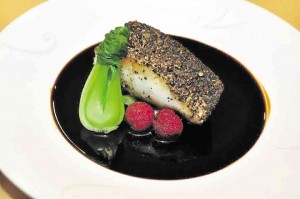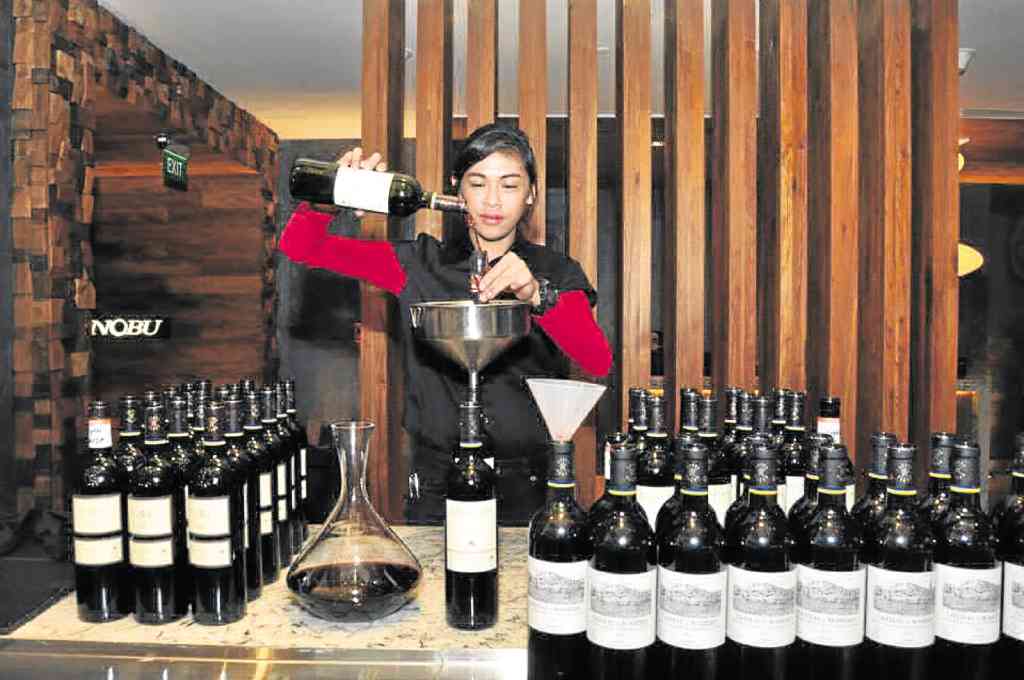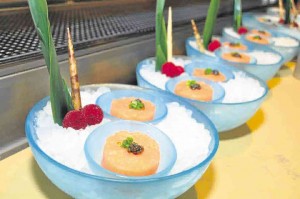Domaines de Barons Rothschild (Lafite) collection holds court
I called Wine Story a couple of days after the grand launch on Feb. 16 of the Domaines de Barons Rothschild (Lafite) collection at the City of Dreams, just to see what’s available in the Philippine market.
It has the following: 1988 vintage priced at P93,995; 1990 vintage, P106,995, as it received 96 points from Robert Parker; 1995 vintage, P97,995; and 2001 and 2002 at around P98,000 each.
Consider it a collector’s item or a special occasion wine.
“This is what in fashion would be haute couture,” explained Michel Negrier, export director of Domaines Barons de Rothschild. “It is for a special occasion; a 10th anniversary. It is not for every day.”
First growth
Lafite is special because it is considered one of only five wines that merited the status of “first growth,” based on an official classification of wines established by Emperor Napoleon III in 1855, called the 1855 Bordeaux Wine Official Classification of 1855.
Wines were ranked in a Grand Cru Classe list from first to fifth growths. The best of the best wines were assigned the highest rank of Premier Cru or “first growth.” Only four wines were worthy of being called Premier Cru: Chateau Latour, Chateau Lafite Rothschild, Chateau Margaux and Chateau Haut-Brion; with Mouton Rothschild joining this elite list in 1973.
“Is there really a big difference in taste between a first growth and a fourth growth wine?” I asked Negrier. The difference is revealed through time. “Between a first growth and a fourth growth of the same vintage, after five years, one might hardly be able to tell the difference. But after 10 years, you will notice that the first growth is becoming more elegant, more beautiful, while the fourth growth will just have plateaued. Then after 15 or 25 years, the first growth will be amazing, while the fourth growth will start to diminish. And a Lafite can continue to get better for up to 150 years while others from the Pauillac commune peak at 10 to 15 years,” Negrier explained.
Pauillac
Realistically, neither the most astute tycoons nor the worst plunderers or jueteng lords can have a premier cru every day.
Even the guys over at Lafite realize this and have expanded their label to include a more pragmatic collection.
This includes the Chateau Duhart-Milon, a 4th cru classe but also from the Pauillac appellation. While still a special wine and by no means for everyday drinking, this is a much more accessible label (also available at Wine Story now in half bottles), prices depending on the vintage range from P13,000 to P38,000. This is the wine that Negrier said he would personally choose for his own 10th anniversary, as even 4th growth wines from Pauillac are generally excellent up to 15 years.
Everyday Lafite
But to make every day a happy Lafite day, the brand has created The Collection—wines that are for everyday appreciation or for “discovery,” i.e., affordable wines to introduce tasting notes to the virgin wine lover.
This includes a Legende Pauillac made from grapes grown in Lafite’s own vineyards but from younger vines. The seasoned wine lover will know that this cannot be passed off even as a fourth growth Lafite but the good news is that this Pauillac does have a beautiful finish, offering the fullness and complexity for which Pauillac is famous, made accessible enough to appreciate every day.
At the grand launch of The Collection at Nobu Restaurant, this was paired with Nobu’s famous sashimi salad. It was interesting to note that this red went well with the rich tuna, proof that you can upgrade even a simple meal with this humble Pauillac.
France meets Argentina
The company has also decided to expand beyond the soils of Bordeaux to Chile.

NOBU’S Chilean sea bass with balsamic teriyaki was paired with red wine: Los Vascos Grande Reserve 2011.
It took over the Los Vascos estate in 1988, planting 220 hectares with vines. The property was chosen because of its location near the ocean, its micro-climate that is perfect for producing fine wines, and exceptional soil of volcanic origin.
“We went to Chile because the cabernet sauvignon here is very nice, with a beautiful aroma for an entry level wine,” Negrier explained. He describes this line as “easy to drink” and perfect for those who are just starting out in wine appreciation and discovering what aromas and flavors they like and do not like in a wine.
The Los Vascos Grande Reserve 2011 was paired with Nobu’s Chilean sea bass with balsamic teriyaki. Once again, it was interesting to note that this was paired with fish. It’s a great alternative to a pinot noir for a light dinner.
Aside from the Los Vascos estate, Lafite also partnered with the famous Catena family in 1999 to create a single wine that combines French and Argentinian cultures. The Catena family, which has produced wine for three generations, lent its expertise on the terroirs of the Mendoza region that produces Malbec wines while DBR Lafite provided its centuries-old skills in growing and aging cabernet sauvignon. The result was a line that mixed Argentinian identity and Bordeaux style.
At the Nobu dinner, the Amancaya Gran Reserva Malbec was paired with lamb. It was another excellent pairing as the Amancaya was medium bodied and very masculine, with hints of tobacco, espresso and spice, and a dry medium finish.
French loyalty
For those who are loyal to French wines, though, another alternative is Lafite’s Domaine d’Aussieres. Chateau d’Aussieres has been producing wine since the Roman era but DBR Lafite acquired 550 hectares in 1999, devoting 167 hectares to replanting carefully selected Languedoc grape varieties such as Syrah, Grenache, Mourvedre and Carignan, complemented with cabernet, merlot and chardonnay.
Chef Zachary Hillberry paired Nobu short ribs first with the 2011 Blason d’Aussieres then shifted gears while on the same dish to the Chateau d’Aussieres.
So we started with the clean, fresh nose and sweetness of the medium-bodied Blason before escalating to the more full-bodied Chateau (my favorite for the night!). It was quite a trip!
Pleasure
Wines are a complicated lot. After a while, I think winemakers themselves just got tired of explaining the nuances of aromas and terroir so today there are no more rules.
“It’s all about pleasure,” Negrier concluded. “One reason there is so much respect for Lafite wines is that there is so much pleasure in drinking it.”
At the same time, there is a guarantee of quality. “When we put our name on the wine, whatever part of the world it may be, you know you will have elegance, drinkability, soft tannins, no matter what price level,” Negrier added. “We just want to make the wine lover happy.”
Mission accomplished!
For inquiries on The Collection of Domaines Barons de Rothschild (Lafite), call Roxanne Lee at 0920-9218870. Some Legende wines are also available at S&R.
Follow the author: @margauxsalcedo on Twitter, Facebook, Instagram. Visit margauxlicious.com.
















